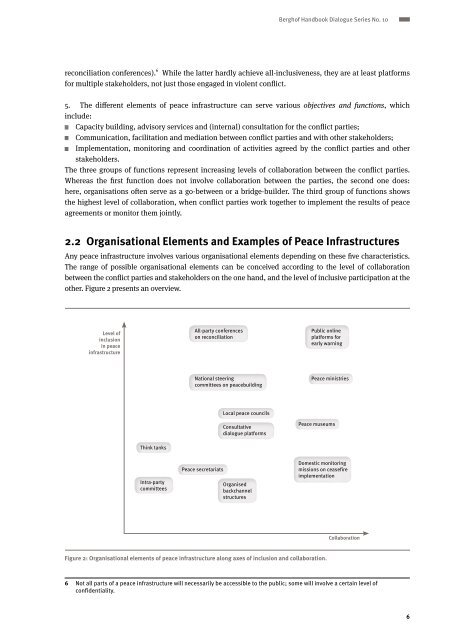Giving Peace an Address? - Berghof Handbook for Conflict ...
Giving Peace an Address? - Berghof Handbook for Conflict ...
Giving Peace an Address? - Berghof Handbook for Conflict ...
You also want an ePaper? Increase the reach of your titles
YUMPU automatically turns print PDFs into web optimized ePapers that Google loves.
<strong>Berghof</strong> H<strong>an</strong>dbook Dialogue Series No. 10<br />
reconciliation conferences). 6 While the latter hardly achieve all-inclusiveness, they are at least plat<strong>for</strong>ms<br />
<strong>for</strong> multiple stakeholders, not just those engaged in violent conflict.<br />
5. The different elements of peace infrastructure c<strong>an</strong> serve various objectives <strong>an</strong>d functions, which<br />
include:<br />
A Capacity building, advisory services <strong>an</strong>d (internal) consultation <strong>for</strong> the conflict parties;<br />
A Communication, facilitation <strong>an</strong>d mediation between conflict parties <strong>an</strong>d with other stakeholders;<br />
A Implementation, monitoring <strong>an</strong>d coordination of activities agreed by the conflict parties <strong>an</strong>d other<br />
stakeholders.<br />
The three groups of functions represent increasing levels of collaboration between the conflict parties.<br />
Whereas the first function does not involve collaboration between the parties, the second one does:<br />
here, org<strong>an</strong>isations often serve as a go-between or a bridge-builder. The third group of functions shows<br />
the highest level of collaboration, when conflict parties work together to implement the results of peace<br />
agreements or monitor them jointly.<br />
2.2 Org<strong>an</strong>isational Elements <strong>an</strong>d Examples of <strong>Peace</strong> Infrastructures<br />
Any peace infrastructure involves various org<strong>an</strong>isational elements depending on these five characteristics.<br />
The r<strong>an</strong>ge of possible org<strong>an</strong>isational elements c<strong>an</strong> be conceived according to the level of collaboration<br />
between the conflict parties <strong>an</strong>d stakeholders on the one h<strong>an</strong>d, <strong>an</strong>d the level of inclusive participation at the<br />
other. Figure 2 presents <strong>an</strong> overview.<br />
Level of<br />
inclusion<br />
in peace<br />
infrastructure<br />
Think t<strong>an</strong>ks<br />
Intra-party<br />
committees<br />
All-party conferences<br />
on reconciliation<br />
National steering<br />
committees on peacebuilding<br />
<strong>Peace</strong> secretariats<br />
Local peace councils<br />
Consultative<br />
dialogue plat<strong>for</strong>ms<br />
Org<strong>an</strong>ised<br />
backch<strong>an</strong>nel<br />
structures<br />
Public online<br />
plat<strong>for</strong>ms <strong>for</strong><br />
early warning<br />
Figure 2: Org<strong>an</strong>isational elements of peace infrastructure along axes of inclusion <strong>an</strong>d collaboration.<br />
<strong>Peace</strong> ministries<br />
<strong>Peace</strong> museums<br />
Domestic monitoring<br />
missions on ceasefire<br />
implementation<br />
Collaboration<br />
6 Not all parts of a peace infrastructure will necessarily be accessible to the public; some will involve a certain level of<br />
confidentiality.<br />
6
















